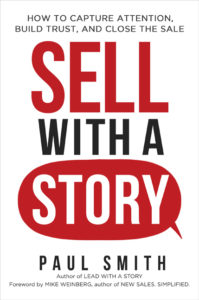Podcast: Play in new window | Download | Embed
Subscribe: RSS
Podcast (sell-with-a-story-series1): Play in new window | Download | Embed
Subscribe: RSS

{The 12th in a series of the 25 most useful sales stories.}
This story marks our transition from the rapport building phase of the sales process to the actual sales pitch itself. And for most salespeople, this is the heart of the matter—this where most of the traditional selling is done, and where most of the time in a typical sales call is spent. So there’s room for lots of stories, and successful salespeople often use more than one.
In fact, I found five different types of stories being told in this phase, and the first one is a story to help the prospect understand how the product or service you’re selling was invented or discovered in the first place.
This is similar to the founding story of your company that I described in a previous article, except it’s about the origin of the particular brand, or product, or service you’re offering at the moment. And it’s important for similar reasons. This story answers the question “What situation gave rise to the inventor creating this product?”
And by helping the buyer see the purpose and passion behind the invention, you help them see your company not just as an impersonal corporate machine, but as a collection of human beings on a mission. And that’s a company your prospect is much more likely to want to do business with. But it also helps them understand on a more personal level what that product could do for them.
Here’s an example from Leah Jewell:
Leah worked for the publishing company Prentice Hall back in the mid-1990s. She managed a team of people in charge of creating books for the English departments at colleges and universities. Part of her job was selling the idea for new books, first to her own internal management, then to the sales reps, and finally to the teachers in the college English departments who were the target audience. The main component of one particular sales pitch was the following story.
She started by simply asking,
Do you know Mickey Harris or the Purdue Online Writing Lab?”
Since her external audience was made up of English professors, they nearly always did. Muriel “Mickey” Harris was fairly well known as the Purdue University English professor who in 1976 created the school’s first writing lab to help students with their writing. She eventually expanded access to the lab and its resources online, establishing one of the world’s earliest online writing labs (OWLs).
Leah continues by explaining that Mickey and her team had personally helped thousands of students with their writing in the previous two decades. And with over half a million words in the English language and more than a thousand grammar rules, you might think that Mickey was helping students with an enormous number of different questions and issues. But after several years, she was surprised to realize that most of the students coming to her writing lab were showing up with a remarkably similar set of questions and problems.
They were so consistent, in fact, that her team developed handouts to address the most common problems. She ultimately concluded that the majority of issues were represented by only 20 unique topics.
Mickey had the data and experience to narrow down the most common writing errors and FAQs she encountered, and Leah and her team figured out a way to organize a book around that information to make it easier for students to find what they were looking for. That way, if students are having problems trying to figure out how to properly use semicolons, for example, they could find the answer quickly and easily without wading through advice on em dashes versus en dashes.
None of the handbooks on the market at the time were organized that way. And Mickey already had a good head start on the material with the reference handouts she’d been writing. It would be a book teachers and students needed, uniquely well organized, and that was largely already written.
The story helped everyone understand the value of Mickey Harris and her idea. That made it easy to get approval to move forward with the project inside Prentiss Hall. The same story helped the sales reps make a compelling case to English professors because the professors saw that the approach solved a problem for them—how to get students to use a handbook effectively.
As a result, The Prentice Hall Reference Guide to Grammar and Usage by Muriel Harris was born. Prentice Hall named Leah’s team the “product team of the year.” And today, the book is in its ninth edition and is still one of the bestsellers on the market.
To Do
So, if you don’t already know the story behind the discovery or invention of all of the products you sell, find someone who does, and ask them to tell you about it. You might need to go to more than one person. Be prepared to do some research. Go to the company archives. Visit some of the old-timers and retirees if you have to. This story is every bit as important as the price lists and spec sheets you have already. Treat it that way.
When you’re done with your research, craft a story around that event and be prepared to share it with your prospects as part of your sales pitch.
Use these links to subscribe to this SWAS podcast on iTunes or Stitcher, or Podbean.
Source: Sell with a Story: How to Capture Attention, Build Trust, and Close the Sale, by Paul Smith.
—
 Paul Smith is one of the world’s leading experts on business storytelling. He’s a keynote speaker, storytelling coach, and bestselling author of the books Lead with a Story, Parenting with a Story, and Sell with a Story.
Paul Smith is one of the world’s leading experts on business storytelling. He’s a keynote speaker, storytelling coach, and bestselling author of the books Lead with a Story, Parenting with a Story, and Sell with a Story.


 Connect with him via email here.
Connect with him via email here.
Follow him on Facebook, LinkedIn, Twitter, and Instagram.
Sign up for his newsletter here to get one new story a week delivered to your inbox.

